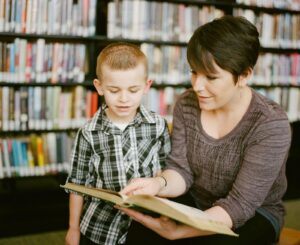 Because it might not be the most popular genre for adults, the role of poetry in developing reading skills may be overlooked. But for a child just developing literacy, poetry has been proven to teach readers about voice, pitch, volume, and inflection, along with also using rhyming as a tool to identify phonetics and word groups.[1] And because of its melodic and dynamic form, poetry is also a prime genre of literature to grasp a young reader’s attention and teach them about language. I mean, who doesn’t remember The Cat in the Hat from their youth?
Because it might not be the most popular genre for adults, the role of poetry in developing reading skills may be overlooked. But for a child just developing literacy, poetry has been proven to teach readers about voice, pitch, volume, and inflection, along with also using rhyming as a tool to identify phonetics and word groups.[1] And because of its melodic and dynamic form, poetry is also a prime genre of literature to grasp a young reader’s attention and teach them about language. I mean, who doesn’t remember The Cat in the Hat from their youth?
A critical characteristic about poetry in the development of literacy skills for young readers is that it focuses the reader specifically on the language used to construct the poem, more than other genres might.[2] In poetry, language is just as important as narrative when it comes to understanding the piece at hand. This means that the reader pays more attention to vocabulary, sentence structure, and literary devices, further enriching their reading skills. And because of the artistic freedom that is lent to poetry, readers have to repeatedly get used to different language structures in understanding different poems, also further developing their literacy skills.
According to the National Reading Panel, the five pillars at the core of every effective reading instruction program are phonemic awareness, phonics, fluency, vocabulary, and comprehension.[3] Poetry is especially effective at focusing on these five pillars of literacy given the integral importance of language to the genre. When it comes to phonemic awareness and phonics—the ability to make out different sounds that make up speech and the ability to match letters to sounds, respectively—poetry effectively tackles these areas by being a genre that is meant to be read aloud, teaching young readers about the relationship between sounds and words, which is the essence of both phonemic awareness and phonics.[4] Furthermore, the common use of rhyming in poetry develops phonemic awareness, or the ability to hear and manipulate sounds in language.[5]
Speaking of rhyming and rhythm, it is these two characteristics of poetry that also help develop a young reader’s vocabulary skills. Poetry, unlike other genres, follows a rhythm that is an essential part of its composition, and it is based on the rhythm of a poem how the rhymes will be produced. Based on this rhyme scheme, the poet has the constrictions of choosing certain rhyming words that could contextually fit into the poem. For the reader, this connection between words usually leads to a larger vocabulary and exposure to words that they might not have otherwise known.[1] For example, if you have children or can recall the works for yourself, think of the idiosyncratic and wide-lexicon of Roald Dahl’s poetry for children, or Dr. Seuss, or Shel Silverstein.
When it comes to fluency, instead of teaching children to simply read quickly, poetry encourages the reader to use critical thinking in bridging the language on the page with poetic devices to understand the meaning of the poem. Although this might slow down the reading process, it lends itself to a deeper comprehension of the poem or work at hand and a greater accuracy of the language used due to the level of discernment that the genre requires.
Finally, when it comes to reading comprehension, it is often the case that for readers just starting out, it is harder to maintain the stamina it takes to read longer texts, leading to less comprehension because there are more details to sort through and remember. This is where poetry can enter as an effective alternative to longer texts, as it offers shorter, more accessible lengths for young readers while still being dense with meaning. In using metaphor, rhyming, and other poetic devices, poetry still offers a reading experience that can enhance comprehension without being too long to tire a reader out.
With poetry being able to tackle the five pillars of effective reading instruction programs, it should be more widely implemented or at least considered when it comes to teaching new minds about the power of language and reading.
How does PSG fit in?
At Publishing Solutions Group, a leading content development company, we understand the transformative power of poetry in early literacy. Poetry isn’t just an art form—it’s a dynamic tool that helps young readers develop essential skills like phonemic awareness, phonics, fluency, vocabulary, and comprehension. Through its rhythmic patterns, rhyming schemes, and focus on language, poetry captivates young minds while laying the foundation for lifelong reading success.
We specialize in creating engaging, curriculum-aligned resources that bring language to life for early learners. Together, we can nurture a love for language and reading that lasts a lifetime.
Contact Publishing Solutions Group today and discover how we can support your literacy goals!
[1] https://readingpartners.org/blog/poetry-can-help-kids-develop-reading-skills/#:~:text=Reading%20poetry%20helps%20children%20about,the%20words%20on%20a%20page
[2] https://ila.onlinelibrary.wiley.com/doi/10.1002/trtr.1734
[3] https://www.azed.gov/sites/default/files/2017/11/5%20pillars%20infographic%20Poster.pdf
[4] https://www.sciencedirect.com/science/article/pii/S1877042810008426/pdf?md5=9066574a1d44211dc21e480a0d2aac6f&pid=1-s2.0-S1877042810008426-main.pdf
[5] https://readingpartners.org/blog/poetry-helps-kids-learn-read/#:~:text=The%20frequency%20of%20rhyming%20in,their%20decoding%20and%20comprehension%20abilities
Photo free to use under the Unsplash License.




